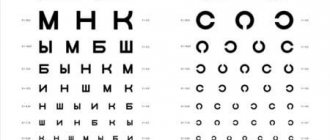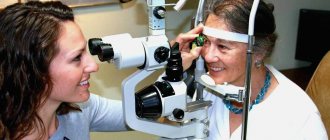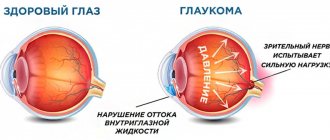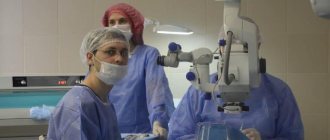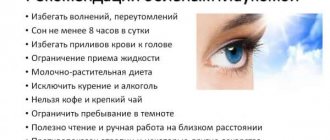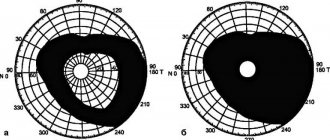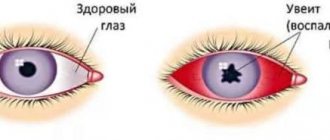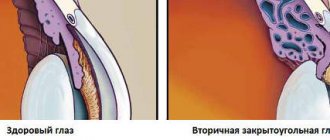Drug treatment of glaucoma
Modern conservative treatment of glaucoma is carried out in three directions:
- Treatment aimed at reducing the patient's intraocular pressure (ophthalmic hypotensive therapy);
- Treatment to improve blood supply to the internal spheres of the eye (the membranes and the intraocular part of the optic eye);
- Treatment aimed at normalizing the metabolic processes of eye tissue to inhibit degenerative processes characteristic of glaucoma.
It is worth mentioning right away that the main point in the treatment of glaucoma is considered to be the normalization of intraocular pressure (IOP), while methods for improving blood circulation and influencing the metabolic processes of the eye are only of an auxiliary nature. The correct work and rest schedule for a patient with glaucoma is also of therapeutic importance.
With regular use of anti-glaucoma drops, the patient needs to be aware of the existence of the following options for the action of the drugs:
- A decrease in intraocular pressure occurs after the first application (instillation) of the drug. Repeated instillations regularly repeat this effect;
- The effect of the drops does not appear immediately. It is mild at first, but intensifies in subsequent days, provided that the drug is regularly applied to the eye;
- From the very beginning, there is resistance (immunity) to the drug and it does not have any effect on IOP;
- The drug has a paradoxical effect - after its administration, the pressure does not decrease, but on the contrary, it can increase, sometimes quite significantly. That is why the prescription of antiglaucamatous therapy requires a mandatory diagnostic test for each drug.
Thus, the prescription of medications to reduce intraocular pressure is the prerogative of the exclusive ophthalmologist, who is able to take into account many factors when choosing the optimal therapy. You cannot self-medicate, prescribe or discontinue anti-glaucoma medications on your own! You cannot change the frequency of instillations without consulting your doctor! Such actions can cause irreparable harm to the eyes!
Prescribing instillation of antiglaucoma drops requires dynamic observation of the patient by a doctor for at least 2-3 weeks. And subsequent monitoring of the effectiveness of treatment at least once every 3 months. Every 1-2 years, a mandatory replacement of the drug is recommended, with appropriate monitoring of the development of resistance to it.
Drugs used to treat glaucoma are divided into two groups: drugs that suppress the production of aqueous humor and drugs that activate the outflow of intraocular fluid from the eye.
Antiglaucoma agents for topical use
I. Drugs to improve the outflow of intraocular fluid
Miotics
- Pilocarpine. Solutions of “Pilocarpine hydrochloride” 1%, 2%, 4% produced (Russia, Ukraine), “Oftanpilocarpine” 1% (produced in Finland), “Isopto-carpine” 1%, 2%, 4% (produced in the USA), etc.
- Carbachol. Solution "Isopto-carbachol" 1.5%, 3% (made in the USA)
Sympathomimetics
- Epinephrine. Glaucon solution 1%, 2% produced (USA), epiphrine solution 0.5%, 1%, 2% (USA).
- Dipivefrin. Solution "Oftan-dipivefrin" 0.1% (Finland)
Prostaglandins
- Travoprost. Travatan solution 0.004% (made in the USA).
- Patanoprost. Xalatan solution 0.005% (made in the USA)
II. Drugs to inhibit the production of intraocular fluid
Selective sympathomimetics
- Clonidine (Clonidine). Solution "Clonidine" 1.125%, 0.25%, 0.5% (made in Russia)
Beta blockers
- Non-selective adrenergic blockers (ß1,2). Timolol solution 0.25%, 0.5%. Solution "Oftan timolol" (made in Finland), solutions "Timolol-LENS" and "Timolol-DIA" (made in Russia), solution "Timohexal" (made in Germany), solution "Arutimol" (made in the USA), solution "Kuzimolol" ( produced in Spain), solution "Niolol" (made in France), solutions "Ocumed", "Ocumol" (made in India), solutions "Timoptic" and "Timoptic-depot" - extended action (made in the Netherlands).
- Selective adrenergic blockers (ß1). Betaxolol solution 0.5%. "Betoptik" solution 0.5%, "Betoptik S" ophthalmic suspension 0.25% (made in Belgium)
Carbonic anhydrase inhibitors
- Brinzolamide. "Azopt" ophthalmic suspension 1% (made in the USA)
- Dorzolamide. Trusopt solution 2% (made in the USA)
III. Combination drugs
- Proxofelin solution (proxodolol + clonidine) (made in Russia)
- Fotil solution (timolol 0.5% + pilocarpine 2%) (made in Finland)
- Fotil forte solution (timolol 0.5% + pilocarpine 4%) (made in Finland)
- Normoglaucon solution (pilocarpine 2% + metypranolol) (made in Germany)
- Cosopt solution (dorzolamide 2% + timolol 0.5%) (made in France)
The drugs of first choice, as a rule, are: Timolol, Pilocarpine, prostaglandins (Travatan, Xalatan).
Second choice drugs: Brinzolamide, Dorzolamide, Betaxalol, Proxodolol, Dipivefrin, Clonidine, etc.
Helper Methods
Medicinal herbs and berries help in healing from glaucoma. This is not an independent treatment, but complements the main therapeutic course. Herbs and berries saturate the body with minerals and vitamins, contributing to overall health and normalization of visual function.
Herbs for glaucoma:
- nettle;
- lily of the valley flowers;
- aloe;
- Golden mustache;
- anise;
- Dill seeds.
Nettle and lily of the valley are used as applications on the eyes. Three pinches of dry nettle, one pinch of lily of the valley flowers are poured into a cup of cold boiled water. This mixture should sit for 9-10 hours in a dark place. Then add half a teaspoon of baking soda to the infusion, soak cotton pads in the mixture and make lotions. It is enough to lie down with lotions for 15 minutes twice a day.
Aloe infusion is made to irrigate the eyes. The bottom leaf of the plant is crushed and placed in a cup of boiling water. The mixture is infused for 3 hours. The eyes are washed with filtered liquid (2-3 times a day).
Golden mustache is used for instillations. However, using this product on its own is dangerous for the eyes; you should consult an ophthalmologist. An infusion for drinking is also prepared from the golden mustache.
To strengthen the immune system, eat berries and pollen. Ten grams of pollen are eaten daily for 30 days.
Berries for glaucoma:
- rosehip decoction;
- red rowan;
- Red Ribes;
- viburnum;
- strawberries
Shilajit is also widely used. This natural substance is taken daily, 2 grams, washed down with freshly prepared beet juice. The procedure is carried out half an hour before breakfast. Details of treatment should be clarified with an ophthalmologist.
Glaucoma: symptoms
The main danger of glaucoma is that in the early stages it is asymptomatic and begins to manifest itself only when the pathological changes in the eye are too strong.
The first sign of glaucoma is loss of peripheral vision, which is often ignored and the disease continues to progress.
The symptoms of glaucoma largely depend on the form of the disease.
Open angle shape
Due to the slow development of the disease, there are no pronounced symptoms for a long time. Often the patient does not even suspect that his vision is deteriorating, since those parts of the eye that are responsible for peripheral vision are initially damaged.
Severe disorders usually appear in old age and are detected during a vision test by an ophthalmologist.
Closed angle acute form
Symptoms of this form of glaucoma are:
- severe headaches in the temporal and parietal regions;
- redness and pain in the eyes;
- with prolonged headache, nausea and vomiting may occur;
- blurred vision.
These symptoms occur sporadically, last for several hours and disappear again. But with each new appearance, visual function worsens more and more. These pathological changes are irreversible, so treatment for glaucoma should begin as early as possible.
Congenital glaucoma
It is very difficult to identify this form of the disease, since a small child cannot complain about the state of his health.
Possible symptoms of congenital glaucoma may include:
- increased eye size;
- strabismus;
- photophobia;
- eye twitching;
- increased lacrimation;
- "blurred" look.
How to buy drops?
The online pharmacy Lekpharm offers a wide range of medications for glaucoma. Medicines have licenses and quality certificates. Having selected the required product in the catalog, you can order it in one click. Consultants working online will provide all the information about the methods of application, characteristics and cost of the product.
The price in an online pharmacy is much lower than in retail. The customer can save money, as sales are regularly held, there are discounts, and a bonus system operates. The order will be delivered to its destination as soon as possible by courier service or Nova Poshta.
Authors
- Sychev D.A.
, Doctor of Medical Sciences, Professor, Head of Department; - Moshetova L.K.
, Doctor of Medical Sciences, Professor, Academician of the Russian Academy of Sciences, head of the department.
Despite all the measures taken, there is no significant reduction in mortality from cardiovascular diseases (CVD) in Russia.
CVDs continue to be the leading cause of death in the Russian Federation (RF), although according to the Russian Ministry of Health, mortality from cardiovascular diseases in Russia decreased by 4% in 2013. However, among the working population, the proportion of cardiovascular mortality is 32% for men and 27.9% for women. About 13% of the Russian population suffers from coronary heart disease (CHD), 1% of the population suffers from chronic heart failure (CHF) [1].
At the same time, the basis of most CVDs leading to death is atherosclerosis. Such high CVD and mortality in the Russian population are primarily due to the high prevalence of cardiovascular risk factors, which can be divided into modifiable (arterial hypertension, hyperlipidemia, diabetes mellitus/impaired glucose tolerance, smoking, obesity, hyperuricemia, physical inactivity, etc.) and non-modifiable (age, gender, heredity).
The most common CVDs are coronary artery disease, arterial hypertension (AH), CHF, and cardiac arrhythmias (of which atrial fibrillation is the most common). All these patients require long-term pharmacotherapy using drugs that, on the one hand, reduce the risk of cardiovascular complications (primarily heart attacks and strokes), and on the other, improve the quality of life (increase exercise tolerance, reduce the frequency of hypertensive crises, angina attacks, paroxysms of atrial fibrillation, etc.), which has been proven in numerous multicenter randomized clinical studies performed in accordance with the methodology of evidence-based medicine [2].
In this case, as a rule, patients with CVD receive a certain “set” of medications, which include antiplatelet agents (usually acetylsalicylic acid in small doses), beta-blockers, diuretics, ACE inhibitors, slow calcium channel blockers, organic nitrates, hypolipidemic ( more often - statins), antiarrhythmics (more often - amiodarone) [2].
Taking into account the fact that both glaucoma and cardiovascular diseases are most common in the older age group, their combination when managing this category of patients can cause a number of problems that can be divided into three groups [3]:
- the effect of drugs used for glaucoma on the cardiovascular system and the course of CVD;
- the effect of drugs used for CVD on intraocular pressure and the course of glaucoma;
- interactions between drugs used for CVD and drugs used for glaucoma.
